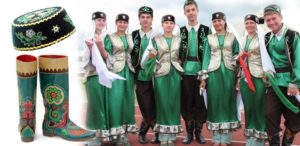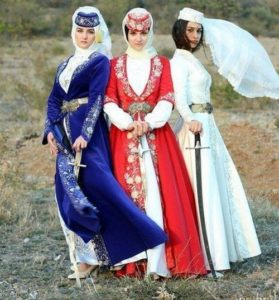The national costume is a kind of calling card of each nationality. Fashion trends are constantly changing, but the national costume continues to be the distinctive feature and pride of every nation. The traditions of its production are carefully preserved and passed on from generation to generation in descriptions and photos.
Features and varieties of Tatar national costume

The main component of both men's and women's attire is an elongated, spacious shirt. Its mandatory components should be wedges on the side and a deep cutout on the front. The shirt was worn without a belt and decorated with various decorative elements. The silhouette of the clothing is trapezoidal. The most important component is a belt made of bright velvet and decorated with the most valuable fur or gilded ribbon. It was decorated with large gold and silver buckles. Bloomers were made from thick linen fabrics.
The expression of national color is most clearly expressed in women's costume.It looks much richer than men's, since Tatar women have been trained in sewing, embroidery and various handicrafts since childhood. It is characterized by a fitted silhouette, giving women exquisite grace.
Over a long shirt with large sleeves, women wore a sleeveless vest or camisole. The camisole was made of colored or plain velvet, and the length had to cover the knees. It could be either with sleeves or without a bottom. It was decorated with coins, feathers and other beautiful items. They also wore stockings made from cloth materials or knitted from woolen threads.
Both women's and men's clothing were decorated with expensive and valuable fur skins. The fur of beaver, sable, marten, and black-brown fox was highly valued. In winter, fur coats were added to the traditional outfit. The folk costume is decorated with an abundance of embroidered elements.
Important! Clothing for children was made in the image and likeness of adult clothing. A distinctive feature is the abundance of all kinds of bright details and bright, eye-catching colors.
Boys also wore loose, long shirts. Cuffs were sewn onto the sleeves for convenience. Young people also wore smart camisoles and trousers in contrasting colors. The girls' outfits are even more sophisticated.
During long evenings, their mothers and grandmothers created exclusive outfits for their beauties. Dresses were sewn multi-tiered. They completely covered all parts of the body and were very long. The head was decorated with a traditional headdress, from which an almost transparent fabric hung down, covering the back.
Festive costumes and modern style among the Tatars

Nowadays, people in traditional costumes can hardly be seen walking along city streets.However, costume designers love to use them to create images for dances or performances. In general, costumes should retain the basic colors of national clothing, but may differ in a variety of design solutions. For example, there is no longer a strict connection to the length of the suit.
Women's clothing has become much shorter over time. But in the decor they try to preserve traditional floral patterns. The kalfak also remained a mandatory attribute. You can see such a hat of the most intricate shapes. More often it is sewn to match the color of the dress of its owner.
Reference! Traditional costumes are especially in demand for festive events, such as weddings.
The bride's dress can be either snow-white or made in bright, catchy colors. It must be long and cover all parts of the body. A good addition to it are the traditional camisole and kalfak. A huge number of different jewelry is certainly welcome: bracelets, massive earrings and rings.
The abundance of expensive jewelry indicates the high social status of its owner. Grooms prefer regular classic suits decorated with multi-colored ribbons. If the wedding takes place under stricter observance of customs, then the man should be dressed in a traditional shirt and camisole made of velvet.
In the manufacture of modern clothing:
- Light and airy materials such as silk or satin are popular;
- They love to experiment with combining materials in color and texture, creating unusually complex combinations;
- In the process of developing clothes, we first of all listen to the wishes of people and their taste preferences.
What materials are used for the national costumes of the Tatars

A variety of materials were used to make clothing. These were mainly tissue compounds and chicken animals. The edges of the clothes were decorated with fur inserts. They also loved using exquisite velvet in a contrasting color. Over time, clothing began to perform other functions and became much lighter. Accordingly, less dense fabrics began to be used.
Wool, cotton and silk were popular. Camisoles were made from patterned brocade and made from brocade. For everyday wear, cheaper and more wear-resistant materials were used. For festive dresses, fabrics were often created by hand with original designs and decorations, without skimping on expensive stones, furs and other decorations.
Attention! In ancient times, special attention was paid to the color characteristics of products. Colors for the Tatars served as a certain reflection of the realities of life. Each color reflects a person's religious preferences and his position in the social hierarchy.
For example, in the 19th century, the color red symbolized belonging to a certain family and class, and later the financial independence of a person. After some time, this color began to be widely used in festive attire at various celebrations. But most people associate white clothing with old age and mourning events.
Currently, there is a tendency to use a variety of catchy and even daring shades. Emerald, lilac and blue colors are increasingly being used, combined with contrasting tones and bright patterns. An outfit embroidered with gold looks more elegant.
Accessories to complement the national costume

The main part of the costume is the headdress, from which a knowledgeable person can easily determine the social status, age characteristics, and marital status of its owner. Main types of hats:
- Skullcap. It is a man's headdress. It can be either a small hat at home or for going out. A large number of interesting materials, ornaments and decorations were used in their manufacture. That is why museum collections now contain a huge number of different versions of this clothing;
- Kalfak. It was worn by women and you could tell a lot by its appearance. So, if a girl was not married, she was supposed to wear a white kalfak. For married women, they were sorted in a certain way depending on the clan. The shape of the products could also differ. Most of them resembled a man's skullcap in appearance. The caps with a pointed cloth end, decorated with a fringe of golden threads, looked interesting;
- Fur hats were especially popular during the cold season. They were shaped like a cylinder and had a flat top. They were made from valuable fur. They mainly used astrakhan fur and added inserts from the fur of sable, marten, beaver and other animals. With such a hat they wore a special skullcap called kalyapush. It was made of velvet and also impressively decorated, despite the fact that it was only an addition to the main thing;
- Cover. A special point should be made about the bedspread. Wearing it was mandatory. This is due to the peculiarities of ancient pagan beliefs. Since ancient times, it was believed that hair had special magical properties. Each religion has its own special clothing requirements.For example, adherents of Islam must cover their faces and heads, and also hide the shapes and outlines of their figures under massive fabrics;
- The nakosnik is a special type of decoration for a woman’s head. They are very diverse in design, decoration and color scheme.
The clothing of the Tatars stands out among the outfits of other peoples due to the abundance of all kinds of high-quality decorations and the brightness of the colors. Jewelry was worn by everyone, regardless of age and gender. The male part of the population wore voluminous rings with stones. Women also preferred large and massive jewelry, often very heavy. They were worn around the neck, arms and ears. One of the most ancient and favorite types of accessories were earrings. They began to be worn from early childhood until old age.
An integral part of the national costume are earrings with interesting pendants. During the course of conquest and communication with foreigners, elements from products of the Caucasian and Russian peoples, as well as Central Asia and Kazakhstan, appear in jewelry.
Earrings in the form of rings and with three stones were popular among women. Also, in addition to the aesthetic function, decorations on the neck also served another purpose. For example, decorations in the chest area held separate parts of clothing together and covered a deep neckline. One of the unusual decorations is considered to be a sling. It is made of fabric and is shaped like a ribbon. It was worn slung over the shoulder. Adherents of Islam sewed separate pockets there and kept the texts of prayers there.
Times have changed and people wear comfortable European-style clothes, but the national costume remains a source of special pride.Returning to their roots, the Tatars wear it with great respect on the main family holidays and pass on the tailoring features to their descendants.


 0
0





